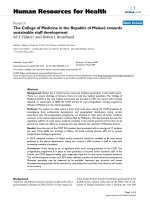Báo cáo sinh học: "Homoclinic solutions of some second-order non-periodic discrete systems" ppt
Bạn đang xem bản rút gọn của tài liệu. Xem và tải ngay bản đầy đủ của tài liệu tại đây (227.63 KB, 23 trang )
This Provisional PDF corresponds to the article as it appeared upon acceptance. Fully formatted
PDF and full text (HTML) versions will be made available soon.
Homoclinic solutions of some second-order non-periodic discrete systems
Advances in Difference Equations 2011, 2011:64 doi:10.1186/1687-1847-2011-64
Yuhua Long ()
ISSN 1687-1847
Article type Research
Submission date 15 July 2011
Acceptance date 20 December 2011
Publication date 20 December 2011
Article URL />This peer-reviewed article was published immediately upon acceptance. It can be downloaded,
printed and distributed freely for any purposes (see copyright notice below).
For information about publishing your research in Advances in Difference Equations go to
/>For information about other SpringerOpen publications go to
Advances in Difference
Equations
© 2011 Long ; licensee Springer.
This is an open access article distributed under the terms of the Creative Commons Attribution License ( />which permits unrestricted use, distribution, and reproduction in any medium, provided the original work is properly cited.
Homoclinic solutions of some
second-order non-periodic discrete
systems
Yuhua Long
College of Mathematics and Information Sciences,
Guangzhou University, Guangzhou 510006, P. R. China
Email address:
Abstract
In this article, we discuss how to use a standard minimizing argument
in critical point theory to study the existence of non-trivial homoclinic
solutions of the following second-order non-autonomous discrete systems
∆
2
x
n−1
+ A∆x
n
− L(n)x
n
+ ∇W (n, x
n
) = 0, n ∈ Z,
without any periodicity assumptions. Adopting some reasonable as-
sumptions for A and L, we establish that two new criterions for guaran-
teeing above systems have one non-trivial homoclinic solution. Besides
1
that, in some particular case, for the first time the uniqueness of homo-
clinic solutions is also obtained.
MSC: 39A11.
Keywords: homoclinic solution; variational functional; critical point;
subquadratic second-order discrete system.
1. Introduction
The theory of nonlinear discrete systems has widely been used to study discrete
models appearing in many fields such as electrical circuit analysis, matrix the-
ory, control theory, discrete variational theory, etc., see for example [1, 2]. Since
the last decade, there have been many literatures on qualitative properties of
difference equations, those studies cover many branches of difference equations,
see [3-7] and references therein. In the theory of differential equations, homo-
clinic solutions, namely doubly asymptotic solutions, play an important role in
the study of various models of continuous dynamical systems and frequently
have tremendous effects on the dynamics of nonlinear systems. So, homoclinic
solutions have extensively been studied since the time of Poincar´e, see [8-13].
Similarly, we give the following definition: if x
n
is a solution of a discrete sys-
tem, x
n
will be called a homoclinic solution emanating from 0 if x
n
→ 0 as
|n| → +∞. If x
n
= 0, x
n
is called a non-trivial homoclinic solution.
For our convenience, let N, Z, and R be the set of all natural numbers,
2
integers, and real numbers, respectively. Throughout this article, | · | denotes
the usual norm in R
N
with N ∈ N, (·, ·) stands for the inner product. For
a, b ∈ Z, define Z(a) = {a, a + 1, . . .}, Z(a, b) = {a, a + 1, . . . , b} when a ≤ b.
In this article, we consider the existence of non-trivial homoclinic solutions
for the following second-order non-autonomous discrete system
∆
2
x
n−1
+ A∆x
n
− L(n)x
n
+ ∇W (n, x
n
) = 0 (1.1)
without any periodicity assumptions, where A is an antisymmetric constant
matrix, L(n) ∈ C
1
(R, R
N×N
) is a symmetric and positive definite matrix for
all n ∈ Z, W (n, x
n
) = a(n)V (x
n
), and a : R → R
+
is continuous and V ∈
C
1
(R
N
, R). The forward difference operator ∆ is defined by ∆x
n
= x
n+1
−x
n
and ∆
2
x
n
= ∆(∆x
n
).
We may think of (1.1) as being a discrete analogue of the following second-
order non-autonomous differential equation
x
+ Ax
− L(t)x + W
x
(t, x) = 0 (1.2)
(1.1) is the best approximations of (1.2) when one lets the step size not be
equal to 1 but the variable’s step size go to zero, so solutions of (1.1) can give
some desirable numerical features for the corresponding continuous system
(1.2). On the other hand, (1.1) does have its applicable setting as evidenced
by monographs [14,15], as mentioned in which when A = 0, (1.1) becomes the
second-order self-adjoint discrete system
∆
2
x
n−1
− L(n)x
n
+ ∇W (n, x
n
) = 0, n ∈ Z, (1.3)
3
which is in some way a type of the best expressive way of the structure of
the solution space for recurrence relations occurring in the study of second-
order linear differential equations. So, (1.3) arises with high frequency in
various fields such as optimal control, filtering theory, and discrete variational
theory and many authors have extensively studied its disconjugacy, disfocality,
boundary value problem oscillation, and asymptotic behavior. Recently, Bin
[16] studied the existence of non-trivial periodic solutions for asymptotically
superquadratic and subquadratic system (1.1) when A = 0. Ma and Guo [17,
18] gave results on existence of homoclinic solutions for similar system (1.3).
In this article, we establish that two new criterions for guaranteeing the above
system have one non-trivial homoclinic solution by adopting some reasonable
assumptions for A and L. Besides that, in some particular case, we obtained
the uniqueness of homoclinic solution for the first time.
Now we present some basic hypotheses on L and W in order to announce
our first result in this article.
(H
1
) L(n) ∈ C
1
(Z, R
N×N
) is a symmetric and positive definite matrix and
there exists a function α : Z → R
+
such that (L(n)x, x) ≥ α(n)|x|
2
and
α(n) → +∞ as |n| → +∞;
(H
2
) W (n, x) = a(n)|x|
γ
, i.e., V (x) = |x|
γ
, where a : Z → R such that
a(n
0
) > 0 for some n
0
∈ Z, 1 < γ < 2 is a constant.
4
Remark 1.1 From (H
1
), there exists a constant β > 0 such that
(L(n)x, x) ≥ β|x|
2
, ∀n ∈ Z, x ∈ R
N
, (1.4)
and by (H
2
), we see V ( x) is subquadratic as |x| → +∞ and
∇W (n, x) = γa(n)|x|
γ−2
x (1.5)
In addition, we need the following estimation on the norm of A. Concretely,
we suppose that (H
3
) A is an antisymmetric constant matrix such that A <
√
β, where β is defined in (1.4).
Remark 1.2 In order to guarantee that (H
3
) holds, it suffices to take A
such that A is small enough.
Up until now, we can state our first main result.
Theorem 1.1 If (H
1
)-(H
3
) are hold, then (1.1) possesses at least one
non-trivial homoclinic solution.
Substitute (H
2
)
by (H
2
) as follows
(H
2
)
W (n, x) = a(n)V (x), where a : Z → R such that a(n
1
) > 0 for some
n
1
∈ Z and V ∈ C
1
(R
N
, R), and V (0) = 0. Moreover, there exist constants
M > 0, M
1
> 0, 1 < θ < 2 and 0 < r ≤ 1 such that
V (x) ≥ M|x|
θ
, ∀x ∈ R
N
, |x| ≤ r (1.6)
and
|V
(x)| ≤ M
1
, ∀x ∈ R
N
. (1.7)
5
Remark 1.3 By V (0) = 0, V ∈ C
1
(R
N
, R) and (1.7), we have
|V (x)| = |
1
0
(V
(µx), x)dµ| ≤ M
1
|x|, (1.8)
which yields that V (x) is subquadratic as |x| → +∞.
We have the following theorem.
Theorem 1.2 Assume that (H
1
), (H
2
)
and (H
3
) are satisfied, then (1.1)
possesses at least one non-trivial homoclinic solution. Moreover, if we suppose
that V ∈ C
2
(R
N
, R) and there exists constant ω with 0 < ω < β −
√
βA
such that
a(n)V
(x)
2
≤ ω, ∀n ∈ Z, x ∈ R
N
, (1.9)
then (1.1) has one and only one non-trivial homoclinic solution.
The remainder of this article is organized as follows. After introducing
some notations and preliminary results in Section 2, we establish the proofs of
our Theorems 1.1 and 1.2 in Section 3.
2. Variational structure and preliminary results
In this section, we are going to establish suitable variational structure of (1.1)
and give some lemmas which will be fundamental importance in proving our
main results. First, we state some basic notations.
Letting
E =
x ∈ S :
n∈Z
[(∆x
n
)
2
+ (L(n)x
n
, x
n
)] < +∞
,
6
where
S = {x = {x
n
} : x
n
∈ R
N
, n ∈ Z}
and
x = {x
n
}
n∈Z
= {. . . , x
−n
, . . . , x
−1
, x
0
, x
1
, . . . , x
n
, . . .}.
According to the definition of the space E, for all x, y ∈ E there holds
n∈Z
[(∆x
n
, ∆y
n
) + ( L(n)x
n
, y
n
)]
=
n∈Z
[(∆x
n
, ∆y
n
) + (L
1
2
(n)x
n
, L
1
2
(n)y
n
)]
≤
n∈Z
(|∆x
n
|
2
+ |L
1
2
(n)x
n
|
2
)
1
2
·
n∈Z
(|∆y
n
|
2
+ |L
1
2
(n)y
n
|
2
)
1
2
< +∞.
Then (E, < ·, · >) is an inner space with
< x, y >=
n∈Z
[(∆x
n
, ∆y
n
) + ( L(n)x
n
, y
n
)], ∀x, y ∈ E
and the corresponding norm
x
2
=
n∈Z
[(∆x
n
)
2
+ (L(n)x
n
, x
n
)], ∀x ∈ E.
Furthermore, we can get that E is a Hilbert space. For later use, given β > 0,
define l
β
= {x = {x
n
} ∈ S :
n∈Z
|x
n
|
β
< +∞} and the norm
x
l
β
=
β
n∈Z
|x
n
|
β
= x
β
.
Write l
∞
= {x = {x
n
} ∈ S : |x
n
| < +∞} and
x
l
∞
= sup
n∈Z
|x
n
|.
7
Making use of Remark 1.1, there exists
β
x
2
l
2
=
β
n∈Z
|
x
n
|
2
≤
n∈Z
[(∆
x
n
)
2
+ (
L
(
n
)
x
n
, x
n
)] =
x
2
,
then
x
l
∞
≤ x
l
2
≤ β
−
1
2
x (2.1)
Lemma 2.1 Assume that L satisfies (H
1
), {x
(k)
} ⊂ E such that x
(k)
x.
Then x
(k)
→ x in l
2
.
Proof Without loss of generality, we assume that x
(k)
0 in E. From
(H
1
) we have α(n) > 0 and α(n) → +∞ as n → ∞, then there exists D > 0
such that |
1
α(n)
| =
1
α(n)
≤ holds for any > 0 as |n| > D.
Let I = {n : |n| ≤ D, n ∈ Z} and E
I
= {x ∈ E :
n∈I
[(∆x
n
)
2
+L(n)x
n
·x
n
] <
+∞}, then E
I
is a 2DN-dimensional subspace of E and clearly x
(k)
0 in
E
I
. This together with the uniqueness of the weak limit and the equivalence
of strong convergence and weak convergence in E
I
, we have x
(k)
→ 0 in E
I
, so
there has a constant k
0
> 0 such that
n∈I
|x
(k)
n
|
2
≤ , ∀k ≥ k
0
. (2.2)
By (H
1
), there have
|n|>D
|x
(k)
n
|
2
=
|n|>D
1
α(n)
· α(n)|x
(k)
n
|
2
≤
|n|>D
α(n)|x
(k)
n
|
2
≤
|n|>D
(L(n)x
(k)
n
, x
(k)
n
)
≤
|n|>D
[(∆x
(k)
n
)
2
+ (L(n)x
(k)
n
, x
(k)
n
)] = x
(k)
2
.
8
Note that is arbitrary and x
(k)
is bounded, then
|n|>D
|x
(k)
n
|
2
→ 0, (2.3)
combing with (2.2) and (2.3), x
(k)
→ 0 in l
2
is true.
In order to prove our main results, we need following two lemmas.
Lemma 2.2 For any x(j) > 0, y(j) > 0, j ∈ Z there exists
j∈Z
x(j)y(j) ≤
j∈Z
x
q
(j)
1
q
·
j∈Z
y
s
(j)
1
s
,
where q > 1, s > 1,
1
q
+
1
s
= 1.
Lemma 2.3 [19] Let E be a real Banach space and F ∈ C
1
(E, R ) satisfying
the PS condition. If F is bounded from below, then
c = inf
E
F
is a critical point of F .
3. Proofs of main results
In order to obtain the existence of non-trivial homoclinic solutions of (1.1) by
using a standard minimizing argument, we will establish the corresponding
variational functional of (1.1). Define the functional F : E → R as follows
F (x) =
n∈Z
1
2
(∆x
n
)
2
+
1
2
(L(n)x
n
, x
n
) +
1
2
(Ax
n
, ∆x
n
) − W(n, x
n
)
=
1
2
x
2
+
1
2
n∈Z
(Ax
n
, ∆x
n
) −
n∈Z
W (n, x
n
). (3.1)
9
Lemma 3.1 Under conditions of Theorem 1.1, we have F ∈ C
1
(E, R)
and any critical point of F on E is a classical solution of (1.1) with x
±∞
= 0.
Proof We first show that F : E → R. By (1.4), (2.1), (H
2
), and Lemma
2.2, we have
0 ≤
n∈Z
|W (n, x
n
)| =
n∈Z
|a(n)||x
n
|
γ
≤
n∈Z
|a(n)|
2
2−γ
2−γ
2
n∈Z
|x
n
|
γ
2
γ
γ
2
= a(n)
2
2−γ
x
γ
2
≤ β
−
γ
2
a(n)
2
2−γ
x
γ
< +∞ (3.2)
Combining (3.1) and (3.2), we show that F : E → R.
Next we prove F ∈ C
1
(E, R ). Write F
1
(x) =
1
2
x
2
+
1
2
n∈Z
(Ax
n
, ∆x
n
),
F
2
(x) =
n∈Z
W (n, x
n
), it is obvious that F(x) = F
1
(x) − F
2
(x) and F
1
(x) ∈
C
1
(E, R). And by use of the antisymmetric property of A, it is easy to check
< F
1
(x), y >=
n∈Z
[(∆x
n
, ∆y
n
) + (Ax
n
, ∆y
n
) + (L(n)x
n
, y
n
)], ∀y ∈ E. (3.3)
Therefore, it is sufficient to show that F
2
(x) ∈ C
1
(E, R).
Because of V (x) = |x|
γ
, i.e., V ∈ C
1
(R
N
, R), let us write ϕ(t) = F
2
(x+th),
10
0 ≤ t ≤ 1, for all x, h ∈ E, there holds
ϕ
(0) = lim
t→0
ϕ(t) − ϕ(0)
t
= lim
t→0
F
2
(x + th ) −F
2
(x)
t
= lim
t→0
1
t
n∈Z
[V (n, x
n
+ th
n
) − V (n, x
n
)]
= lim
t→0
n∈Z
∇V (n, x
n
+ θ
n
th
n
) · h
n
=
n∈Z
∇V (n, x
n
) · h
n
where 0 < θ
n
< 1. It follows that F
2
(x) is Gateaux differentiable on E.
Using (1.5) and (2.1), we get
|∇W (n, x
n
)| = |γa(n)|x
n
|
γ−2
x
n
| = γa(n)|x
n
|
γ−1
≤ γa(n)x
γ−1
l
∞
≤ γa(n)β
−
1
2
x
γ−1
= da(n) (3.4)
where d = γβ
−
1
2
x
γ−1
is a constant. For any y ∈ E, using (2.1), (3.4) and
lemma 2.2, it follows
|
n∈Z
(∇W (n, x
n
), y
n
)| ≤
n∈Z
da(n)|y
n
|
= d
n∈Z
a(n)|y
n
| ≤ d
n∈Z
|a(n)|
2
1
2
n∈Z
|y
n
|
2
1
2
≤ da(n)
2
n∈Z
1
β
(L(n)y
n
, y
n
)
1
2
≤
d
√
β
a(n)
2
y
11
thus the Gateaux derivative of F
2
(x) at x is F
2
(x) ∈ E and
< F
2
(x), y >=
n∈Z
(∇W (n, x
n
), y
n
), ∀x, y ∈ E.
For any y ∈ E and ε > 0, when y ≤ δ, i.e.,|y| ≤ α
−
1
2
δ there exists δ > 0
such that
|∇W (n, x
n
+ y
n
) − ∇W(n, x
n
)| < ε.
is true. Therefore,
| < F
2
(x + y) − F
2
(x), h > | = |
n∈Z
(∇W (n, x
n
+ y
n
) − ∇W (n, x
n
), h
n
)|
≤ ε
n∈Z
|h
n
| ≤ εβ
−
1
2
h,
that is
F
2
(x + y) −F
2
(x) ≤ εβ
−
1
2
.
Note that ε is arbitrary, then F
2
: E → E
, x → F
2
(x) is continuous and
F
2
(x) ∈ C
1
(E, R ). Hence, F ∈ C
1
(E, R ) and for any x, h ∈ E, we have
< F
(x), h > = < x, h > −
n∈Z
(∇W (n, x
n
), h
n
)
=
n∈Z
[(−(∆x
n−1
)
2
+ (Ax
n
, ∆x
n
) + ( L(n)x
n
, x
n
) − ∇ W (n, x
n
), h
n
)]
that is
< F
(x), x >= x
2
−
n∈Z
(∇W (n, x
n
), x
n
) (3.5)
Computing Fr´echet derivative of functional (3.1), we have
∂F (x)
∂x(n)
= −∆
2
x
n−1
− A∆x
n
+ L(n)x
n
− ∇W (n, x
n
), n ∈ Z
12
this is just (1.1). Then critical points of variational functional (3.1) corresponds
to homoclinic solutions of (1.1).
Lemma 3.2 Suppose that (H
1
), (H
2
) in Theorem 1.1 are satisfied. Then,
the functional (3.1) satisfies PS condition.
Proof Let {x
(k)
}
k∈N
⊂ E be such that {F (x
(k)
)}
k∈N
is bounded and
{F
(x
(k)
)} → 0 as k → +∞. Then there exists a positive constant c
1
such that
|F (x
(k)
)| ≤ c
1
, F
(x
(k)
)
E
≤ c
1
, ∀k ∈ N. (3.6)
Firstly, we will prove {x
(k)
}
k∈N
is bounded in E. Combining (3.1), (3.5)
and remark 1.1, there holds
(1 −
µ
2
)x
(k)
2
= < F
(x
(k)
), x
(k)
> −µF (x
(k)
)
+
n∈Z
[(∇W (n, x
(k)
n
), x
(k)
n
) − µW(n, x
(k)
n
)]
≤ < F
(x
(k)
), x
(k)
> −µF (x
(k)
)
together with (3.6)
(1 −
µ
2
)x
(k)
2
≤ c
1
x
(k)
+ µc
1
. (3.7)
Since 1 < µ < 2, it is not difficult to know that {x
(k)
}
k∈N
is a bounded
sequence in E. So, passing to a subsequence if necessary, it can be assumed
that x
(k)
x in E. Moreover, by Lemma 2.1, we know x
(k)
→ x in l
2
. So for
k → +∞,
< F
(x
(k)
) − F
(x), x
(k)
− x >→ 0,
13
and
n∈Z
(∇W (n, x
(k)
n
) − ∇W (n, x
n
), x
(k)
n
− x
n
) → 0.
On the other hand, by direct computing, for k large enough, we have
< F
(x
(k)
) − F
(x), x
(k)
− x >
= x
(k)
− x
2
−
n∈Z
(∇W (n, x
(k)
n
) − ∇ W (n, x
n
), x
(k)
n
− x
n
).
It follows that
x
(k)
− x → 0,
that is the functional (3.1) satisfies PS condition.
Up until now, we are in the position to give the proof of Theorem 1.1.
Proof of Theorem 1.1 By (3.1), we have, for every m ∈ R \ {0} and
x ∈ E \{0},
F (mx) =
m
2
2
x
2
+
m
2
2
n∈Z
(Ax
n
, ∆x
n
) −
n∈Z
W (n, mx
n
)
=
m
2
2
x
2
+
m
2
2
n∈Z
(Ax
n
, ∆x
n
) − | m|
γ
n∈Z
a(n)|x
n
|
γ
≥
m
2
2
x
2
−
m
2
2
β
−
1
2
Ax
2
− β
−
γ
2
|m|
γ
a(n)
2−γ
2
x
γ
. (3.8)
Since 1 < γ < 2 and A <
√
β, (3.8) implies that F (mx) → +∞ as |m| →
+∞. Consequently, F (x) is a functional bounded from below. By Lemma 2.3,
F (x) possesses a critical value c = inf
x∈E
F (x), i.e., there is a critical point
x ∈ E such that
F (x) = c, F
(x) = 0.
14
On the other side, by (H
2
), there exists δ
0
> 0 such that a(n) > 0 for any
n ∈ [n
0
− δ
0
, n
0
+ δ
0
]. Take c
0
∈ R
N
\ {0} and let y ∈ E be given by
y
n
=
c
0
sin[
2π
2δ
0
(n − n
1
)], n ∈ [n
0
− δ
0
, n
0
+ δ
0
]
0, n ∈ Z \ [n
0
− δ
0
, n
0
+ δ
0
]
Then, by (3.1), we obtain that
F (my) =
m
2
2
y
2
+
m
2
2
β
−
1
2
Ay
2
− |m|
γ
n
0
+δ
0
n=n
0
−δ
0
a(n)|y
n
|
γ
,
which yields that F (my) < 0 for |m| small enough since 1 < γ < 2, i.e., the
critical point x ∈ E obtained above is non-trivial.
Although the proof of the first part of Theorem 1.2 is very similar to the
proof of Theorem 1.1, for readers’ convenience, we give its complete proof.
Lemma 3.3 Under the conditions of Theorem 1.2, it is easy to check that
< F
(x), y >=
n∈Z
[(∆x
n
, ∆y
n
) + (Ax
n
, ∆y
n
) + (L(n)x
n
, y
n
) −(∇W (n, x
n
), y
n
)]
(3.9)
for all x, y ∈ E. Moreover, F (x) is a continuously Fr´echet differentiable func-
tional defined on E, i.e., F ∈ C
1
(E, R) and any critical point of F (x) on E is
a classical solution of (1.1) with x
±∞
= 0.
Proof By (1.8) and (2.1), we have
0 ≤
n∈Z
|W (n, x
n
)| =
n∈Z
|a(n)| · | V (x
n
)| ≤ M
1
n∈Z
|a(n)| · | x
n
|
≤ M
1
n∈Z
|a(n)|
2
1
2
·
n∈Z
|x
n
|
2
1
2
= M
1
a
2
x
2
≤ β
−
1
2
M
1
a
2
x,
15
which together with (3.1) implies that F : E → R. In the following, according
to the proof of Lemma 3.1, it is sufficient to show that for any y ∈ E,
n∈Z
(∇W (n, x
n
), y
n
), ∀x ∈ E
is bounded. Moreover, By (1.8), (2.1), and Lemma 2.2, there holds
|
n∈Z
(∇W (n, x
n
), y
n
)| ≤
n∈Z
|∇W (n, x
n
)| · |y
n
|
≤ M
1
n∈Z
|a(n)| · | x
n
| · | y
n
|
≤ M
1
a
2
x
2
y
2
≤ M
1
β
−1
a
2
xy
which implies that
n∈Z
(∇W (n, x
n
), y
n
) is bounded for any x, y ∈ E.
Using Lemma 2.1, the remainder is similar to the proof of Lemma 3.1, so
we omit the details of its proof.
Lemma 3.4 Under the conditions of Theorem 1.2, F (x) satisfies the PS
condition.
Proof From the proof of Lemma 3.2, we see that it is sufficient to show
that for any sequence {x
(k)
}
k∈N
⊂ E such that {F(x
(k)
)}
k∈N
is bounded and
F
(x
(k)
) → 0 as k → +∞, then {x
(k)
}
k∈N
is bounded in E.
In fact, since {F (x
(k)
)}
k∈N
is bounded, there exists a constant C
2
> 0 such
that
|F (x
(k)
)| ≤ C
2
, ∀k ∈ N. (3.10)
16
Making use of (1.8), (3.1), (3.15), and Lemma 2.2, we have
1
2
x
(k)
2
= F (x
(k)
) −
1
2
n∈Z
(Ax
(k)
n
, ∆x
(k)
n
) +
n∈Z
W (n, x
(k)
n
)
≤ C
2
+
1
2
β
−
1
2
Ax
(k)
2
+ M
1
n∈Z
|a(n)||x
(k)
n
|
≤ C
2
+
1
2
β
−
1
2
Ax
(k)
2
+ M
1
β
−
1
2
a
2
x
(k)
,
which implies that {x
(k)
}
k∈N
is bounded in E, since A <
√
β.
Combining Lemma 2.1, the remainder is just the repetition of the proof of
Lemma 3.2, we omit the details of its proof.
With the aid of above preparations, now we will give the proof of Theorem
1.2.
Proof of Theorem 1.2 By(1.8), (2.1), (3.1), and Lemma 2.2, we have,
for every m ∈ R \{0} and x ∈ E \ {0},
F (mx) =
m
2
2
x
2
+
m
2
2
n∈Z
(Ax
n
, ∆x
n
) −
n∈Z
W (n, mx
n
)
≥
m
2
2
x
2
−
m
2
2
β
−
1
2
Ax
2
− β
−
1
2
M
1
|m|a(n)
2
x,
which yields that F (mx) → +∞ as |m| → +∞, since A <
√
β. Conse-
quently, F (x) is a functional bounded from below. By Lemmas 2.3 and 3.4,
F (x) possesses a critical value c = inf
x∈E
F (x), i.e., there is a critical point
x ∈ E such that
F (x) = c, F
(x) = 0.
In the following, we show that the critical point x obtained above is non-
trivial. From (H
2
)
, there exists δ
1
> 0 such that a(n) > 0 for any n ∈
17
[n
1
− δ
1
, n
1
+ δ
1
]. Take c
1
∈ R
N
with 0 < |c
1
| = r where r is defined in (H
2
)
and let y ∈ E be given by
y
n
=
c
1
sin[
2π
2δ
1
(n − n
1
)], n ∈ [n
1
− δ
1
, n
1
+ δ
1
]
0, n ∈ Z \ [n
1
− δ
1
, n
1
+ δ
1
]
Then, for every n ∈ Z, |y| ≤ r ≤ 1. By (1.6), (2.1), and (3.1), we obtain that
F (my) ≤
m
2
2
y
2
+
m
2
2
β
−
1
2
Ay
2
− M|m|
θ
n
1
+δ
1
n=n
1
−δ
1
a(n)|y
n
|
θ
,
which yields that F (my) < 0 for |m| small enough since 1 < θ < 2, i.e., the
critical point x ∈ E obtained above is non-trivial.
Finally, we show that if (1.9) is true, then (1.1) has one and only one non-
trivial homoclinic solution. On the contrary, assuming that (1.1) has at least
two distinct homoclinic solutions x and y, by Lemma 3.3, we have
0 = (F
(x) − F
(y), x − y) = x − y
2
−
n∈Z
(Ax
n
− Ay
n
, ∆x
n
− ∆y
n
)
+
n∈Z
(∇W (n, x
n
) − ∇ W (n, y
n
), x
n
− y
n
).
18
According to (1.9), with Lemma 2.2, we have
0 = (F
(x) − F
(y), x − y)
= x − y
2
−
n∈Z
(Ax
n
− Ay
n
, ∆x
n
− ∆y
n
) +
n∈Z
(aV
(x
n
) − aV
(y
n
), x
n
− y
n
)
≥ x − y
2
−
n∈Z
(Ax
n
− Ay
n
, ∆x
n
− ∆y
n
) −
n∈Z
[a
V
(x
n
) − V
(y
n
)
|x
n
− y
n
|
|x
n
− y
n
|
2
]
= x − y
2
−
n∈Z
(Ax
n
− Ay
n
, ∆x
n
− ∆y
n
) −
n∈Z
aV
(z)|x
n
− y
n
|
2
≥ x − y
2
−
n∈Z
(Ax
n
− Ay
n
, ∆x
n
− ∆y
n
) − aV
(z)
2
x
n
− y
n
2
2
≥ x − y
2
−
n∈Z
(Ax
n
− Ay
n
, ∆x
n
− ∆y
n
) − ω
1
β
x
n
− y
n
2
≥ x − y
2
− (
n∈Z
|Ax
n
− Ay
n
|
2
)
1
2
(
n∈Z
|∆x
n
− ∆y
n
|
2
)
1
2
−
ω
β
x
n
− y
n
2
≥ x − y
2
−
A
√
β
x − y
2
−
ω
β
x
n
− y
n
2
= x − y
2
(
β −
√
βA − ω
β
),
where z ∈ E and z ∈ (x, y), which implies that x − y = 0, since 0 < ω <
β −
√
βA, that is, x ≡ y for all n ∈ Z.
Competing interests
The authors declare that they have no competing interests.
Acknowledgments
This study was supported by the Xinmiao Program of Guangzhou Univer-
sity, the Specialized Fund for the Doctoral Program of Higher Eduction (No.
19
20071078001) and the project of Scientific Research Innovation Academic Group
for the Education System of Guangzhou City. The author would like to thank
the reviewer for the valuable comments and suggestions.
References
[1] Mawin, J, Willem, M: Critical Point Theory and Hamiltonian Systems,
pp. 7–24. Springer, New York (1989)
[2] Long, YM: Period solution of perturbed superquadratic Hamiltonian sys-
tems. Annalen Scola Normale Superiore di Pisa Series 4, 17, 35–77 (1990)
[3] Agarwal, RP, Grace, SR, O’Rogan, D: Oscillation Theory for Difference
and Functional Differencial Equations. Kluwer Academic Publishers, Dor-
drecht (2000)
[4] Guo, ZM, Yu, JS: The existence of subharmonic solutions for superlinear
second order difference equations. Sci. China 33, 226–235 (2003)
[5] Yu, JS, Guo, ZM: Boundary value problems of discrete generalized
Emden-Fowler equation. Sci. China 49A(10), 1303–1314 (2006)
[6] Zhou, Z, Yu, JS: On the existence of homoclinic solutions of a class of
discrete nonlinear periodic systems. J. Diff. Equ. 249, 1199–1212 (2010)
20
[7] Zhou, Z, Yu, JS, Chen, YM: Homoclinic solutions in periodic difference
equations with saturable nonlinearity. Sci. China 54(1), 83–93 (2011)
[8] Poincar ´e, H: Les m´ethods nouvelles de la m´ecanique c´eleste. Gauthier-
Villars, Paris (1899)
[9] Moser, J: Stable and Random Motions in Dynamical Systems. Princeton
University Press, Princeton (1973)
[10] Hofer, H, Wysocki, K: First order elliptic systems and the existence of ho-
moclinic orbits in Hamiltonian systems. Math. Ann. 288, 483–503 (1990)
[11] Omana, W, Willem, M: Homoclinic orbits for a class of Hamiltonian sys-
tems. Diff. Integral Equ. 5, 1115–1120 (1992)
[12] Ding, Y, Girardi, M: Infinitely many homoclinic orbits of a Hamiltonian
system with symmetry. Nonlinaer Anal. 38, 391–415 (1999)
[13] Szulkin, A, Zou, W: Homoclinic orbits forasymptotically linear Hamilto-
nian systems. J. Funct. Anal. 187, 25–41 (2001)
[14] Ahlbrandt, CD, Peterson, AC: Discrete Hamiltonian Systems: Difference
Equations, Continued Fraction and Riccati Equations. Kluwer Academic,
Dordrecht (1996)
[15] Agarwal, RP: Difference Equations and Inequalities, Theory, Metho ds,
and Applications, 2nd edn. Dekker, New York (2000)
21
[16] Bin, HH: The application of the variational methods in the boundary
problem of discrete Hamiltonian systems. Dissertation for doctor degree.
College of Mathematics and Econometrics, Changsha, 2006
[17] Ma, MJ, Guo, ZM: Homoclinic orbits for second order self-adjoint differ-
ence equation. J. Math. Anal. Appl. 323, 513–521 (2006)
[18] Ma, MJ, Guo, ZM: Homoclinic orbits and subharmonics for nonlinear
second order difference equation. Nonlinear Anal.: Theory Methods Appl.
67(6), 1737–1745 (2007)
[19] Rabinowitz, PH: Minimax methods in critical point theory with applica-
tions to differential equations, in CBMS Reg. Conf. Ser. in Math., vol. 65.
American Methematical Society, Providence, RI (1986)
22









